The ocean from northern ice to hot tropics, from the water surface to its deeps is acquired by whales. Where did these amazing giants appear from on our planet?
Some myths of North people tell that the Grand Spirit created the world and many beautiful and useful. When he created an ocean, he decided to house there the biggest and the most beautiful creature. This is how the whale appeared.
Other myths represent the whale as a terrifying monster, obviously because of its huge size. The most terrible and powerful whale was Moby Dick regarded as a devil incarnate. Its destructive power wasn’t a phantom – prototype of the legend was a real cachalot which during almost 30 years spread terror among whale hunter, took down 7 ships and killed at least 30 people.
The origin of whales still remains under wraps for scientists. Fossils suggest that modern cetaceans’ ancestors were lining on land for almost 70 million years and then moved into water.
Scientists suppose that the first whales appeared 55-66 million years ago.
The skeletal remains of MONODONTIDAE representatives appear for the first time 9-10 million years ago on the east of the North Pacific Ocean. To live in water area, the warm-blood animals which breathe the air and feed babies by milk had to undergo internal and external evolutionary transformations. As a result of millions years of evolution cetaceans’ ancestors lost their hair-covering, their bodies got streamlined shape, their hind limbs being of no use disappeared (the fact that cetaceans’ skeleton has a rudimentary pelvic bone and scapulas, which do not transfer a body weight from limbs to trunk, suggests that their ancestors lived onshore), instead of them fluke (propulsion) had formed, and fore limbs became flippers (elevation and turn rudders). Cetaceans retained all features that mammals had and were called secondary aquatic animals.
There were 3 suborders of cetaceans originating from the remote ancestors. Two suborders are living now. Species of the first suborder have adapted to catch single pray, fish mainly, by teeth, and others draw a large amount of small organisms by means of filtering system.
Scientific classification
All animals nursing their babies with milk are combined in the class of MAMMALS. Flesh-eating mammals adapted to aquatic life are combined in the order of CETACEANS.
The order is divided into 3 suborders:
1. Primitive whales (Archeoceti)
A suborder had disappeared almost 30 million years ago and known only by fossils. Some species reached large sizes.
2. Baleen whales (Mysticeti)
A suborder of cetaceans which is characterized by large triangle baleen plates for water filtering instead of teeth. Purl edge of plates forms a sieve cover for plankton filtering.
There are main species: blue whale, gray whale, great polar whale, fin whale, etc.
3. Toothed whales (Odontoceti)
These are cetaceans which have teeth. They eat fish and squid.
The main species are cachalot, killer whale, pilot whales, white whales, etc.
Toothed whales are divided into several families, one of which is MONODONTIDAE family which includes white whales (Belugas) and narwhale (another arctic marine mammals).
Generic name of belugas is "Delphinapterus" which means “dolphin without fin” and the species name “Leucas” means “white”, hence the name “beluga”.
Another widespread name is “sea canaries” because of their vocalizations.
The world population of beluga whales is estimated to be about 62000-80000 species as of 1994.
HABITAT
Beluga whales are entirely arctic and subarctic. They inhabit the North Atlantic, Canadian Arctic, and Arctic Ocean and its adjoining seas – the White Sea, the Barents Sea, the Kara Sea, the Laptev Sea, the East Siberian Sea, the Chukchi Sea, and seas of the Pacific Ocean - the Sea of Okhotsk, the Bering Sea.
Belugas live and hunt as well as in near-shore area and on the open sea. Sometimes thy enter large rivers such as the Amur River and the Yukon raising 1-2 thousand kilometers up-stream.
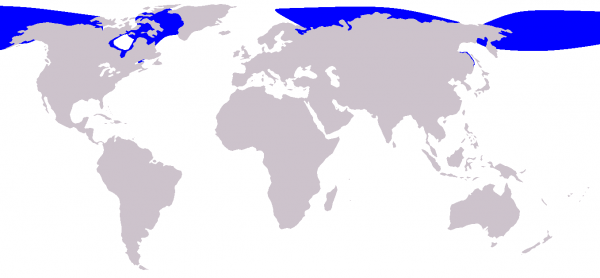
MIGRATION
Beluga’s season migration is caused by water temperature, ice situation change and fish schools migration.
In cold winters they hold the areas with warmer waters. During summer they inhabit the arctic and subarctic seas where water temperature is about 0°. Many animals are also found in rivers’ offing and deltas. That suggests that belugas are well adapted both to the cold ocean water and to the warm river one. In the North Atlantic and Canadian Arctic belugas winter in Hudson Bay, Gulf of Saint Lawrence, in Cumberland Bay, near Greenland. In spring they move to the north – in Baffin Bay, Dennisov Strait, Melville Bay. In autumn they migrate back to the south. In the White Sea belugas are found throughout the year.
Belugas leave Onega Bay in November-January when it is covering by ice and move to deep-water areas. In spring they may be found at the coast when ice breaks away from the banks. At the end of June they dwell in different bays, moving out of the Barents Sea. In the Barents Sea belugas are found at the coast of Cheshskaya Bay, Novaya Zemlya, Frantz Josef Land and Spitzbergen in spring, at the north coast of Kanin Peninsula and at the east coast of Cheshskaya Bay in summer and autumn. They also may dwell Cheshskaya Bay and Kolguev whole winter. In the Kara Sea belugas’ pods are found in winter at the coast of Novaya Zemlya and in southern parts of the sea, in spring – near southeast coast of Novaya Zemlya, Vaigach and Mestny islands, in summer - near Dickson, Taymyr and Sedov Archipelago. In autumn belugas’ pods move by Cape Zhelaniya to the west and near Dickson Island – to the east. There are lots of belugas moving to the north-west of south in the eastern or northern part of the sea. In the Bering Sea animals are found throughout the year, the move from north to south in winter and come back in summer and spring. In the Sea of Okhotsk belugas live constantly throughout the year in different areas.
Physical characteristics and body shape
Size
Males are average 3.4 to 4.6 m long and weigh about 1,500 kg. Females average 3 to 4 m and weigh about 1,360 kg.
Bode shape
A beluga whale's body is fusiform, but stocky and streamlined. Rather small head is separated from long body by neck tapering. The body ends with horizontal tail in form of wide isoscales triangle. This is the main propulsion source of beluga. It may have thick folds of blubber, especially along its ventral surface.
The forelimbs of beluga are pectoral fins. Beluga whales lack a dorsal fin.
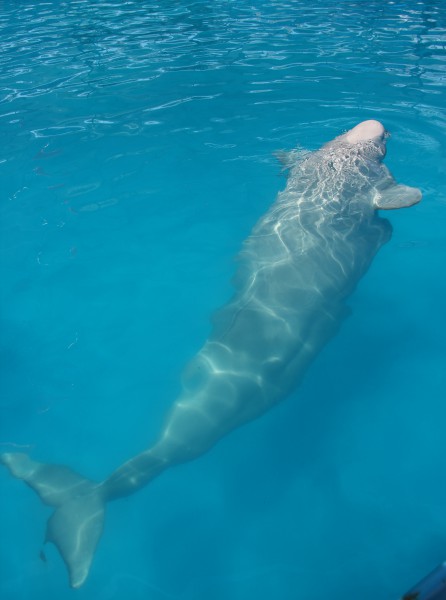
Head
Some cetaceans, for instance, river dolphins, can bend their head up to 45° against their body. The most cetaceans’ neck vertebrae are fused into neck unit, thus, their head is miveless.
The seven neck vertebrae of a beluga whale are not fused, comparing to the most cetaceans. As a result beluga has greater head mobility necessary for near-bottom fish chasing and ice breaking. Skin thickening on the under site of a head protects it from injuries.
Belugas have rather small (relative to body), round-shaped head with short mouth and fatty structure on the forehead.
The fore part of beluga’s face formed by jaws and meant for food snatch is called rostrum. Usually it is wide and short. Its base width is sometimes 70 % of its length.
Belugas have peg-shaped teeth adapted for grasping and tearing rather than chewing. There are more teethes on the upper law (14-22) than on than lower one (12-18). Belugas have an average of 34 teeth.
Eyes are located at the sides of the head. There are glands at the inner corners of the eye socket which secrete jelly mucus that lubricates eyes, washes away debris and renders eyes safe from infection.
Melon is a frontal fat pad, a kind of an acoustic lens. It is surrounded by muscles and changes its shape when the whale is producing sounds.
Ears, located just behind the eyes, are inconspicuous openings with no external ear flaps.
Belugas have unpaired spout-hole (blowhole) located on the top of the head. It’s closed by skin-muscular flap and opens only for short breathing – simultaneous air exhale and intake. When blowhole is closed, its muscles are relaxed, and in order to open it, a beluga tenses valve muscles.
Cetacean do not have external organ of smell.
Pectoral fins
Fore limbs of cetaceans’ remote ancestors transformed into pectoral fins or foreflippers which are paddled, streamlined and drop-shaped providing maneuvering in water. Pectoral fins are used for upward or inward motion control, for turnings and slowing.
Pectoral fins are rather small comparing to body size. They are round- and paddle-formed, slightly curved at the end.
Pectoral fins are used for motion control and slowing. They also are very important for thermoregulation.
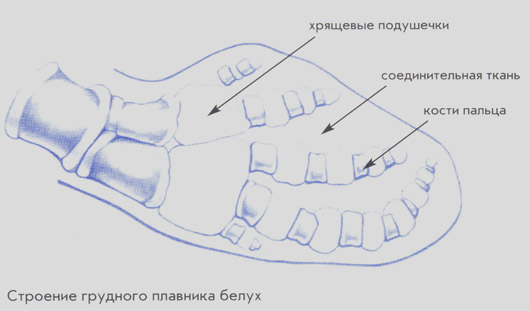
According to embryogeny data, cetaceans’ pectoral fins development is much similar to early stages of land mammals’ forelimbs development. Pectoral fins have the major skeletal elements of the forelimbs of land mammals, but they're shortened and modified. The skeletal elements are rigidly supported by connective tissue. Thick cartilage pads lie between the bones of each digit. Connective tissue lies between the digits.
Pectoral fins of the new-born belugas are no more than 25-30 cm long at a maximum width of 12-15 m. Adult males with body length about 4-4,5 m have pectoral fins 45-50 cm long and 30-35 cm wide. Pectoral fins of males are little smaller than females’ ones.
Belugas’ pectoral fins bend along the edge with age. The bending of fins is individual.
Flukes
Hind limbs became useless and finally disappeared during the evolution. Propulsion function was imposed on two horizontal tail outgrowths called tail flukes. Flukes are solid pads of connective tissue, with no muscles and bones.
Tail swing of a new born beluga is 30-35 cm, of an adult male with body length 4-4,5 m is 1-1,25 m.
Tail stem moves up and down. Blades angled to steam axis: when the stem moves down, blades move up and vice versa. Tail does not rotate while swimming. As well as pectoral fins fluke is very important for thermoregulation
Dorsal fin
Belugas do not have clearly expressed dorsal fin compared to the most cetacean, probably, due to habitation in ice-bond regions. Belugas have a dorsal ridge rather than a dorsal fin .The beluga has a dorsal ridge that runs from just behind the midpoint of the back to the tail flukes. The dorsal ridge may be notched. Absence of dorsal fin increases manoeuvrability while hunting.
Skin
As a result of evolution skin of whales had lost hair, oil and sweat glands, and much thickened.
Skin is smooth, shiny and very firm. It is covered by so-called armour or alapera which is a layer of epidermis twice as thick as skin itself. Obviously, this is an adaptation for life in ice providing both mechanical and heat protection.
Unlike other cetaceans, which tend to generate and shed skin continuously, belugas appear to undergo a seasonal molt of the outer layer of skin.
Coloration

Beluga’s coloration is fully conforms to its name, they are snow white.
Skin color depends on epidermis pigment – melanin.
New-born calves are pale gray with a dash of brown. The base quantity of melanin locates in deep skin compartments of baby-belugas, and thick horny layer provides lighter shade. And within a month, they darken and turn dark grey almost black. Thick epidermis layer is very flimsy and soon surface layer starts to moult. Later as calf grows and, consequently, skin cover increases, coloring lightens. Pigment is not formed anymore, and definitely its amount per unit of the skin area is slowly decreasing as a result of outflow into moulting horny layer. Color of skin becomes blue, at first, than blue-gray, pale gray and finally beluga becomes snow-white. Whitening does not depend on sexual maturation and is not equally fast at different parts of body. Skin coloration may by more intensive in the area of dorsal spin, head, blowhole, fluke and pectoral fins. The older animals have thicker horny layer (3-4 times) and by the old age gain on ivory.
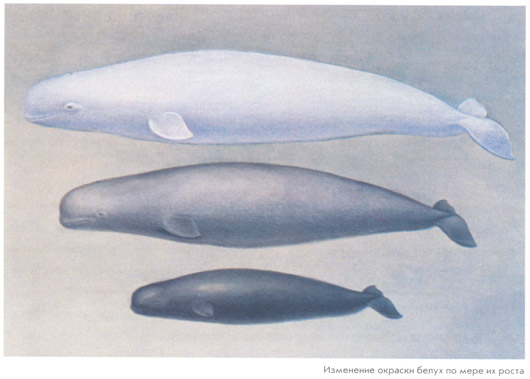
Outworld perception
Hearing and sound perception
The most important sense organ for cetacean is not eyesight as for the land mammals, but hearing and organs of echolocation. This fact had influenced organs of hearing.
Belugas have no external ear flaps. There are small lentiform ear openings, a few inches behind each eye. Each opening leads to a reduced ear canal and an eardrum. The same as all mammals, dolphins perceive sound waves by cochlea located in bony labyrinth of middle ear.
Middle and internal ears of dolphins are not integrated into osteocranum compared to land animals. Sound perceiving parts of the middle ears are independent units, called bulla - "bullа tympani", located in a special bone stock and connected to skull by means of short and thick tendinous connection. As a result, both ears are independent receivers adapted for directional reception of sound source.
Between bulla and skull is a special cavity filled with air or fat emulsion foam located for better protection. The foam consists of micro air bulbs which perfectly isolate sound. As a result all sound vibrations coming from bones of skull do not reach inner ear. The only way to reach cochlea lays through external ear and auditory ossicles.
Middle ear cavity of dolphins is filled with connective tissue with a large amount of blood capillaries that regulated pressure in the middle ear while swimming.
The hearing range of beluga whales is 1,2 to 120 kHz (middle hearing range of a human is only 0,02 to 17 kHz) with best range 10 to 75 kHz.
Echolocation
It is difficult to use eyesight in water which is dense and less transparent than the air. But cetaceans use the sound for orientation in space. It's more accurate to say that they use echoes. An animal sends high-frequency sound waves on some object, whether fish or obstruction, and “listens” to echo returning. This ability is called echolocation.

Toothed whales echolocate by producing clicking sounds and then receiving and interpreting the resulting echo.
Beluga whales produce sound pulses which pass through the melon. The melon acts as an acoustical lens to focus these sound waves into a beam, which is projected forward into the water in front of the whale. Sound wave reflects from an obstruction and echoes back. The brain receives reflected waves in form of nerve pulses and interprets sound image.
Echolocation is a very important for cetaceans way to orientate in space and receive information of the world around. Echo gives them exact information about objects’ location, size, form and material. Beluga can identify size and form of the object. It helps them to recognize a prey they prefer. In dark or muddy water sound is an efficient source of information for belugas as sound waves propagate in water at speed 1,5 km/s (4,5 times faster than in the air).
Echolocation is very important for belugas’ navigation under ice fields and search of holes in ice necessary for breathing.
Communication
The larynx of whales does not possess vocal cords, but belugas are very vocal and considered as the most “communicative” cetacean.
Sounds are probably produced by movements of air between nasal sacs in the blowhole region.
The sounds are very different in loudness, frequency and pattern. Acoustic spectrum of the toothed whales is up to 170 kHz. Frequency of the most signals is within 0,2-12 kHz. Belugas use high-frequency clicks for the echolocation. The frequency and large repertoire of their vocalizations earned them the name "sea canaries". They produce sounds at different day times and depths. Beluga’s vocal is hearable underwater and through ships’ skin. They produce high-frequency resonant whistles, squeals, clucks, mews, chirps, trills, and bell-like tones.
Scientific evidence suggests a certain association between behavioral activity and the types of vocals beluga whales use. For example, researchers have observed that beluga whales tend to emit more squawk-type calls during periods of social interaction than during alarm situations. Squawks were also observed during hunting. And trumpets and roaring are typical only for males.
There is no evidence that beluga whales use anything resembling human language.
Nonverbal communication
Besides vocalizations, belugas may communicate through facial expressions and physical contact. As the other whale species belugas can breach, slap a pectoral flipper on the water's surface, slapping flukes on the water. But such behavior is not as common for belugas as for other whale species.
Vision
Cetaceans’ retina contains two central spots receiving an image (human eye has only one spot). One spot provides vision in water, the other – in air. That is why belugas have acute eyesight both in and out water.
Out water the crystalline lens and the cornea adjust to overcome the myopia caused by change of environment.
Beluga’s retina contains two types of cells: rod cells and cone cells, indicating that they can see both in darkness and in bright light.
The presence of cone cells suggested that beluga’s vision is color, but researches results were negative.
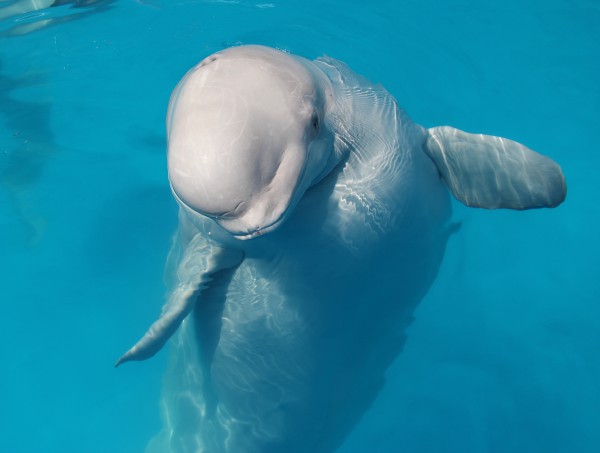
Tacktile
Skin analyzer is a very ancient organ and very important as its function cannot be entrusted to hearing, or locating, or vision.
Skin sensations are very informative. Through skin cetaceans fell water temperature, different pressure of water streams while manoeuvring, fish grabbing, mating games and obstacles overcoming. Cetaceans have a well-developed touch sensibility. Their skin is very sensitive in a broad range compared to human and contains much more nerve-endings comparing to human.
Taste
Biologists have noted sensory areas in beluga whale mouth that may function in taste. Brain and skull nerves features suggest that belugas may have some taste sensation. Beluga whales also have strong preferences for specific species of fish that convinces of their taste.
Smell
Smell plays an important role in life of land animals. By means of smell they search and recognize counterparts and escape from enemies.
Marine animals with short duration of respiration, such as cetaceans, are almost disabled to smell. Olfactory lobes of the brain and olfactory nerves absence of all toothed whales indicates that they do not have a sense of smell.
Chemoreception
Smell sense had been obviously replaced by chemoreception in water. Animals perceive and analyze water chemical composition change. A pod of whales always leaves behind a line of dissolved matters. Thus, other toothed whales are able to get information about counterparts’ behavior.
Toothed whales probably use chemoreception mainly for communication than orientation in the ocean.
Adaptation to water environment
Swimming
Belugas are slow swimmers. They commonly swim about 3 to 9 km/h. But when they are frighten or escaping, they are capable of sustaining a speed up to 22 km/h, but only for as long as 15-20 minutes and being without calves.
Diving
Beluga whales typically don't dive very deep as they hunt mainly near the surface or in shallow water at depths 7-12 meters. Usually they dive to about 20 m and for 3 to 5 minutes but no more than for 20 minutes. Although they are not generally thought of as deep divers, but belugas are capable of diving to extreme depths. Under experimental conditions a trained beluga whale dove to 600 m.
All marine mammals have physiological adaptations for diving. These adaptations enable a beluga whale to conserve oxygen while it's under water:
• Large lung volume and high air capacity factor.
• large blood volume and high concentration of oxygen in blood (beluga whales retain more oxygen in their blood than most mammals do);
• high concentration of hemoglobin in blood and mioglobin concentration in tissues (hemoglobin – blood protein transporting oxygen and carbon dioxide; mioglobin - oxygen-binding protein storing oxygen in order to prevent oxygen deficiency in muscles). While breathing memoglobin and monoglobin saturate oxygen, which is spent during diving very little;
• marine mammals have a slower heart rate while diving. A beluga whale's heart rate slows from about 100 to about 12 to 20 beats per minute during a dive. Blood is shunted away from tissues tolerant to low oxygen level and supplied toward heart, lungs and brain which require constant oxygen. Metabolic rate becomes lower.
• high volume of fat tissue which dissolves more oxygen than tissue fluids do.
Marine mammals have a protection against barotraumas. They have flexible ribcage which can collapse with the water pressure, very elastic lungs tissue which is adapted to fast collapse and expansion.
Breathing
For life in water and air breathing ancestors of modern whales had to change the entire respiratory system. Outer breathing spout – blowhole is on the highest point of animal’s head. Respiratory system and digestive system of toothed whales are completely isolated. Upper air passages of toothed whales have two barriers for air passages isolation from the outer environment.
The first one is a skin-muscular folded flap located in supracranial respiratory passage to which the blowhole opens. Prominences of one fold get into pits of other. The second barrier is a nasopalatine sphincter located in the area of inlet to larynx.
Unlike land mammals, cetaceans start breathing cycle from exhaling. They open the blowhole and begin to exhale when the head is shown above water. Signal for this is change of environment from water to the air (reflex respiration control). Then cetacean quickly inhales and relaxes blowhole muscles to close it.
Belugas breathe more rarely than human do, but during respiration they exchange much air – about 80%, while human – only 17%. Respiratory pause of belugas hiding underwater is about 10-15 minutes, while feeding is no more than 3-5 minutes. When belugas move at average speed, they come up every 20-14 seconds, their average breathing rate is 2-3 breaths per minute. Exhalation-inhalation takes about 07-1,2 second, then back of animal is observed at surface during about 4 seconds before a beluga disappears in water.
As a beluga whale exhales, seawater around the blowhole is carried up with the respiratory gasses. But even if water gets into air passages, it is thrown out by way of blows of water and condensed vapor. A beluga's blow is about 90 cm high.

Thermoregulation
Water thermal conductivity is 25 times higher than the air. High thermal conductivity of water influenced on formation of characteristics providing efficient thermo regulation.
Belugas have thick layer of fat blubber under their skin which serves for isolation, energetic reservation and heat conservation. The main fat lies just below the skin and usually accounts about 40% of body mass. Breathing habits of cetacean have meaning for inner heat storage. Infrequent respiration and breath holding while diving reduce heat dissipation.
Beluga’s blood circulatory system is adapted to conserve or dissipate heat and regulate body temperature.
Arteries in the flippers and flukes are surrounded by veins which form complex vessels. Complex vessel consists of thickwalled muscular artery and venous coil of thinwalled veins around the artery. This vasculature is called a countercurrent heat exchange. Thus, the most heat brought to fins through arteries is transferred to the venous blood and then to internal organs rather than the environment. This system provides minimum heat loss and aids in conserving body heat. In case of overheating blood circulation through near-surface vessels increases and, thus, the organism is cooling. If it’s a need to save heat, arterial blood stream to fins decreases.
When a beluga whale dives, blood is shunted away from the surface of the skin. This decrease in circulation conserves body heat.
Behaviour
Social organization
Beluga whales live in groups called pods. A pod is a stable, long-standing, independent community. It is composed of groups – elementary units. A group may consist of 2 to 20 individuals (the average pod size is about 10).
Pod size and structure depend on members’ age, sex and reproductive conditions. In summer pod’s structure and size are associated to reproductive needs, in autumn and winter - to nutritive conditions and young-stock breeding.
A single large male usually leads a pod. A basis of a stable pod is a female with its brood of different ages. This primary group exists for many years, its size may change depending in female’s age. Many other females breeding their calves may stay in this group. Mature males form their own separate groups. For most of the year they live independently on a separate territory.
Seasonal study of belugas’ pods showed that males can live independently even during breeding season (May-June). There are mostly females with calves in the mixes pods during this period. At the end of breeding season (August) sex- and age-dependent differentiation is more distinct: there are mostly pods of adult females with calves and separate mature males’ pods. Males’ groups are rather stable.
Several smaller pods may join together occasionally to form larger groups (for instance, during migration), called “flocks”. Sometimes such flock numbers in hundreds.
Social behaviour
It’s easier to feed and protect from enemies holding together. One of the main features of all cetaceans is cooperation and collaboration during hunting and migration. For instance, during great seasonal migrations flocks are lead by adult males followed by pods of females with juveniles. One or several healthy animals support weakened counterpart pushing them at the surface to take a breath. Animals coordinate their actions surrounding school of fish during joined hunting.
Play behaviour
Belugas spend almost all spare time playing. Scientists have seen adult belugas at sea carrying fishing nets and even skeletons of killer whales and deers on their backs and playing. They also observed animals playing with balls, buoys and water in captivity. To attract attention, belugas may douche people with water streamlets from mouth. But still playing behavior of belugas is less diverse than dolphins’ or killer whales’.
Diet and eating habits
Belugas usually hold the shore – in bays, gulfs and deltas.
For this reason their diet is very diverse, as there are lots of bottom and midwater organisms. Belugas are omnivorous. They prey on about 100 different kinds of fish, octopus, crabs, shrimps, shells, snails.
In captivity belugas eat approximately 2.53% of their body weight per day, i.e. 15-30 kg of fish.
Hunting
Belugas usually hunt alone, less frequently in groups. The main method of collective hunting is “whirligig”: they encircle a large school of fish and herd it into a small, dense mass. Fish starts moving in a circle. Belugas take turns moving in the middle of the fish “whirligig” to feed.
Animals hunt alone at 0,3-1,0 km distance from each other. As all hunters, at first, they stalk prey, then chase, make fast dash and catch fish.
Beluga whales don't chew their food; they swallow it whole, head first to reduce a possibility of throat injures from sharp spines. They also pull to pieces large fish.
Belugas dig the bottom at shallow waters (in bays, gulfs) while foraging bottom prey. Belugas’ flexible neck allows a wide range of motion.
Reproduction
Maturity range of belugas is rather broad.
Male beluga whales become sexually mature at 8 to 9 years of age, and females at 4 to 7 years. The average reproductive age of females is 8 to 9 years old.
Mating seasons’ period depend mainly on habitat.
Mating seasons coincide with reproduction seasons. Breeding activity is observed most often from March to May-June. Mating dances are very diverse and may be initiated by both male and female. Long mating games of belugas end with touching to each other by different parts of bode.
Belugas breed in small bays, estuaries, at shallow water. Single dominant male mates with several females.
Gestation is about 14-15 months. Though beluga female as well as all cetaceans may become pregnant again after deliveries, it happens not to all mature females. A female give birth every 2 to 3 years. Twins are rare.
Before deliveries a female change its behavior – female slowly swim near the surface, breath faster. Labor is about 30-60 minutes, deliveries are about 2 hours.
Very often assisting belugas present at birth. Although these assistants are called "aunties", they may be male or female. They surround mother and protect her baby
Calves are born March to September, depending on the region, but most are born May to July. Newborns’ body length is about 52% of mother’s body length. Calves are usually 1,5-1,7 m long and weight about 80kg. As well as other cetaceans, they swim at birth.
Foetus of all cetaceans is in tail-first position. Deliveries are also tail-first. It’s very important for deliveries near the surface: calf’s head is in water only at the last moment that reduces risk to be drown at first breath. The umbilical cord snaps during delivery.
In the first few days after birth, the calf's fin and tail flukes are soft. But gradually fins uncurl and stiffen.
Care of offspring
The same as all mothers beluga-mother tenderly nurse and nurture its baby. Calves are nursed underwater, mother moves very slowly. A calf grasps mammary nipple hidden inside of slits on mother’s belly, and mother squirts milk into calf’s mouth.
Calf nurses for the first time a few hours after birth and then nurses each hour. Later nurture breaks increase. The composition of beluga milk depends on individuals and changes throughout the nursing period, but usually milk contains 28% milkfat, 11% protein, 60.3% water, and less than 1% of mineral salt.
Beluga calves nurse with milk for the first year, until their teeth emerge. They then supplement their diets with shrimps and small fishes. Most calves nurse for 20 to 24 months.
Mothers with calves often form pods separate from males. A mother actively teaches baby and prepare for adult life.
Young belugas learn from other members of group watching them and copying their behavior.
Longevity
According to the studies Belugas live about 25-30 years. The most exact age can by esteemed by examining annual growth of tooth layers. Annually a new layer of dental material covers belugas’ teeth. Age can be estimated by examining a sliced section of a tooth and counting these layers. However, it should be considered that up to two thin layers may be reproduced annually.
Researchers use size and coloration to estimate relative ages of belugas, as young belugas are darker than adult ones.
Predators
The most danger enemy of belugas is killer whale. And during belugas’ wintering in ice-holes polar bear hunts them frequently. Killer whales and polar bears prey on beluga whale adults and calves.
Numan impact
Since ancient times, indigenous Arctic peoples of Canada, Alaska, and North Russia have hunted beluga whales.
As early as the 10th century the coast-dwellers hunted belugas harpooning them in the White Sea. Since the 16th century the special cooperative teams had hunted beluga whales with fishing nets.
The quality of beluga’s leather is well-known since old times. “Beluga leather” is mentioned in chronicles of Novgorod of the 11th century. Together with furs it was taken from the North people as a render. A thick belugas’ leather was called referred to as “porpoise leather”.
Until recently belugas were hunted for meat, oil and meal for farms in Russia. Arctic natives hunt belugas for food and other raw materials. This practice is an important part of their culture, but there is some concern that the number of killing may be too high for the current population.
Lots of belugas were killed by fishermen, who believed the whales were a threat to the fishing industry as they hunted valuable fish.
Environment pollutions, destruction of their habitat have an adverse effect on the population of belugas.
Since 2000 commercial killing of beluga whales is prohibited in the Russian Federation. Only limited hunting is allowed for Far North people due to their cultural features and for scientific and educational purposes.
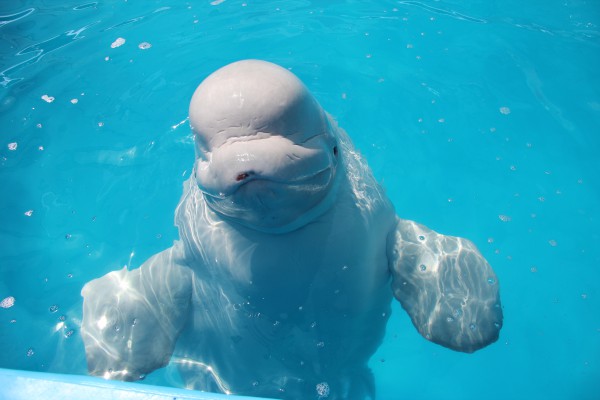
Copyright belongs to N.D. Grechishkina. Any use of the text is only with consent of the author.

